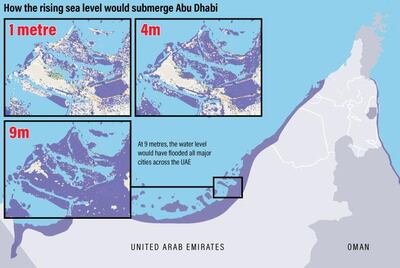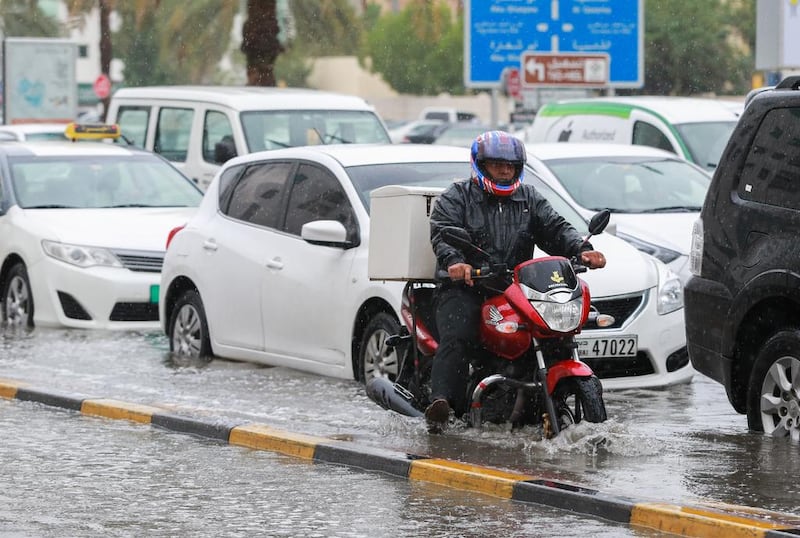Rising sea levels caused by climate change threaten to leave coastal parts of the UAE under water in coming decades, long-range forecasts show.
The second day of the Arab Future Cities Summit in Dubai yesterday heard that low-lying cities such as Abu Dhabi are particularly at risk.
“We have some giant issues that we have to deal with when we look at the scale of planetary ecology,” said Steven Velegrinis, director of urban design at the Dubai office of US architecture and design firm Perkins and Will.
“We have a challenge that no other human civilisation has ever dealt with and that’s looking at how we undo the damage we’ve been doing for quite some time now.”
With billions of people expected to move into cities in the next 30 years, urbanism and over-use of resources are changing the face of the Earth.
“As professionals who work in development, we have to accept that it is our responsibility to plan for this; not just to house people but how we deal with things on a planetary ecology scale,” Mr Velegrinis said. “It’s something we can’t escape here in the region, in Dubai and around the world.
“We need to consider how our work will impact on the ecology of the globe.”
He pointed to statistics showing the effects that a rise of 1 metre in sea level, partly due to melting polar ice caps, would cause.
In March, a long-term forecast for climate change found that environmental changes could lead to 8 per cent of Ajman being lost to rising water, 2 per cent of Sharjah, up to 5.9 per cent of Umm Al Quwain and parts of Abu Dhabi’s islands by 2100.
The UAE Climate Change Risks and Resilience, a report published by Emirates Wildlife Society in March, found that there could be an increase of up to 2°C in summer temperatures and a 10 per cent rise in humidity by 2060.
“It tells us we cannot afford to assume that someone else will take care of the problem,” Mr Velegrinis said.
“You cannot treat cities as separate to nature and we increasingly have to think of cities as third natures, as synthetic ecology that affects positive change. How would it be possible to even live in this region?
“Either we respond to this or we think of where we can move the entire Gulf population to.
“We can’t accept that cities are passive, but rather active agents of change.”
With yearly floods in Saudi Arabia and hurricanes regularly hitting the United States, the Environment Agency Abu Dhabi looked at different scenarios that could occur if the extreme case of the Intergovernmental Panel on Climate Change came to pass.
It includes a sea level rise of 9 metres if climate change causes were not addressed.
The agency found that almost all of urban Dubai would be underwater along with most of the other six emirates.
About 85 per cent of UAE residents live in coastal areas, and artificial shoreline, islands and breakwaters would also be at risk.
“No one can hide from this problem,” Mr Velegrinis said. “We have to include resilient city design and look at things in a different way.”
But given its location, the Gulf is in a good position to tackle such factors.
A study by Masdar found that the urban heating effect is inverted in the region, meaning Gulf cities are cooler than their surrounding landscape.
“No one can figure out why,” Mr Velegrinis said. “Masdar concluded this was happening because of the way we are vegetating the cities and this had a geo-engineering scenario on cities.”
As a result, central Dubai is up to 10°C cooler than its surroundings in the summer, and Doha 6°C cooler.
“City-making doesn’t have to be divorced from planetary ecology and health,” Mr Velegrinis said. “We need to restore that connection and accept that it’s all our responsibility.

“It’s really about designing future cities that are less divorced and stop seeing them separate to landscape and ecology.”
Dr Karim Bergaoui, climate and water modelling scientist at the International Centre for Biosaline Agriculture in Dubai, said that the climate change situation was reaching alarming levels.
“Decision-makers around the world must act to mitigate its causes,” Dr Bergaoui said. “The situation will only get worse if we do not start to take action to avoid depleting our resources and transforming the landscape of the world.
“It is worrying to see how much can go underwater with rising sea levels but there is still an opportunity for people to move away from such a scenario in our lifetime.”
Although the UAE is driving a huge surge in smart housing, the Sheikh Zayed Housing Programme said its projects in Dubai were safe from floods.
___________
Read more:
More sandstorms in summer and rain in winter, UAE climate change risk report predicts
___________
“It’s a very extreme scenario,” said Basem Al Namer, its director of engineering services.
“It’s always better to have a house inland. The issues that could happen are very far in the future but anything can happen.
“We also take into consideration earthquakes when we build our houses, even if we don’t have many of them in the UAE.”





